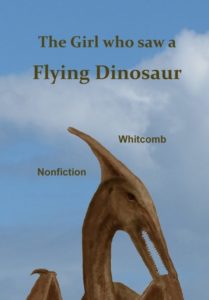In nonfiction writing, how should we hand out criticism? When we find that a person is really in error, we must remember this is a real person, someone whose life in general may have only limited relevance to that error. Consider the alternative you have to offer, and be willing to acknowledge how he may be correct in some detail, in spite of his mistake. By all means concentrate on the truth. An example is in order.
Are Reports of Living Pterosaurs Anecdotes?
In this post, I referred to a critic who disputed the validity of a report of an apparent living pterosaur. I left out the name of the critic, not even linking to his web site. This may be the safest way to point out a weakness in someone else’s written idea, but I also offer this as an example of how not to criticize, for that critic mentioned the name of the U.S. Marine Eskin Kuhn and then flatly declared that his report was a hoax. Since “hoax” includes “lie,” that could be a case of libel; since I found Kuhn to be highly credible (I interviewed him by phone), that criticism of the U.S. Marine appears to be the worst form of criticism.
In part, the critic said in his blog, “I had been planning on writing a post called ‘Thoughts on Eskin Kuhn’s Pterosaur Sighting’ . . . an American soldier named Eskin Kuhn saw a pterosaur while stationed in Cuba. The claim is a hoax. I no longer have the patience for dealing with creationist-related debunkings and I have no intention of actually writing up one for this topic.”
The critic who seems to have carelessly handed out libel wrote only a short paragraph, with no indication of having done any research or detailed analysis. He was then confronted by an unexpected response from an angry Mr. Kuhn. I think the critic could have avoided that confrontation by using common sense and writing responsibly.
This case deserves an explanation. In 1971, Eskin Kuhn was assigned to the Guantanamo Bay Naval Base (a U.S. military installation). One clear day, while he was taking a break outside, he saw two long-tailed creatures flying together, at close range and low altitude, with no obstruction to his view. Being a talented realistic artist, that same day he drew a sketch of the two apparent pterosaurs. He later gave a detailed report for cryptozoologists. For four decades he has stood by his account of his experience, in spite of occasional criticisms or brusque dismissals.
I began my investigations in cryptozoology while actively working as an independent forensic videographer, working with attorney firms, mostly in Southern California. My experiences interviewing accident victims, their caregivers, and others, gave me some foundation for interviewing eyewitnesses of apparent living pterosaurs (not that the accidents were monstrous experiences; I just learned to listen openly and ask appropriate questions for each situation). Early in 2010, I phoned Eskin Kuhn; he had no warning. I questioned him about his 1971 sighting, with the same approach I normally use for those interviews: unlike an attorney questioning a witness in court, more like a detective questioning someone on the street. That approach leaves open all possibilities for discoveries: potential truth in the witness account and potential errors in perception, credibility issues both positive and negative. The person so interviewed rightly perceives I am open to hearing truth, but the questioning subtly allows me to later catch potential problems with credibility and perception, as I review my record and memory of the interview.
Both during my telephone interview with Eskin Kuhn and after reviewing it later, I found him to be highly credible. If there were any hoax, he would have spoken differently than he did, so the careless critic appears to have been completely wrong in his accusation. Since I was not Mr. Kuhn’s attorney, bringing his case to court, I felt no need to mention the name of that critic, although in other cases (other critics of eyewitness accounts) I have mentioned names. But that’s for another post.
__________________________________________________________




Pingback: Living Pterosaurs? Not by Glen Kuban | Modern Pterosaur
Pingback: Infogivmo » Blog Archive » Did Smithsonian Attack Man, Pterosaur, and God?